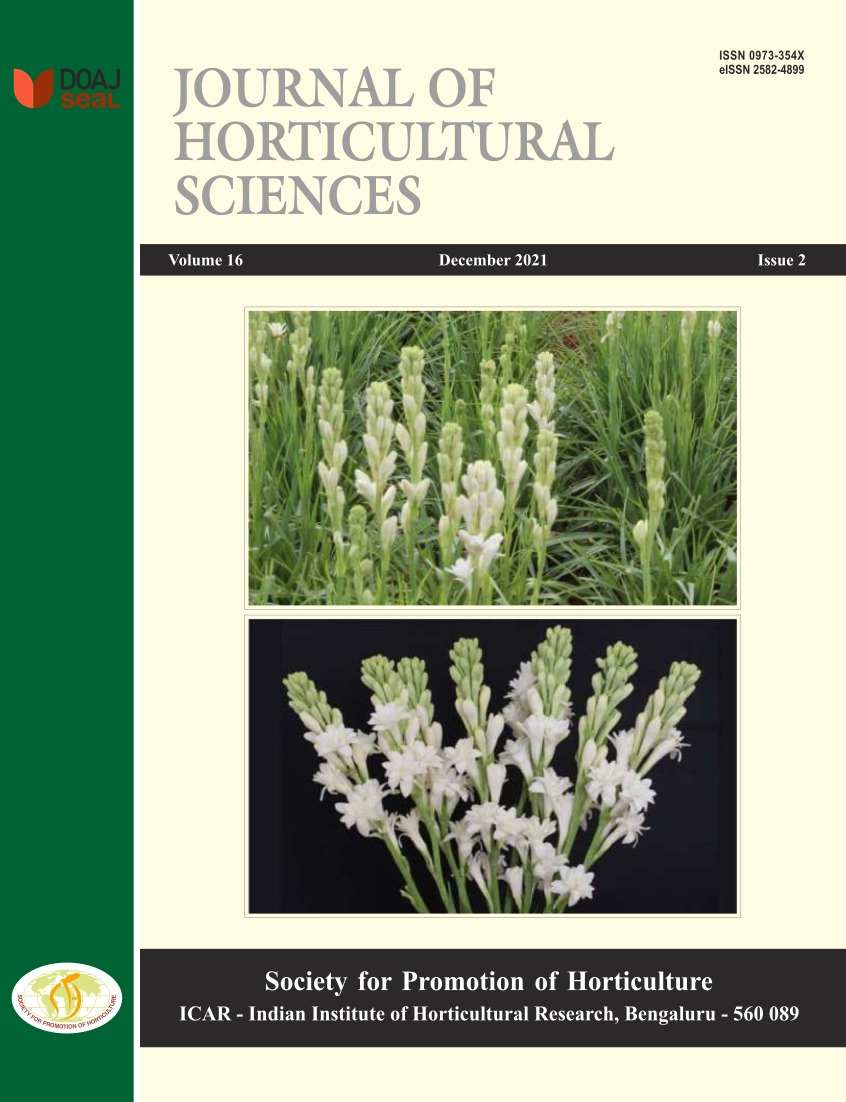Phytoremediation of Indoor Air Pollutants: Harnessing the potential of Plants beyond Aesthetics
DOI:
https://doi.org/10.24154/jhs.v16i2.986Keywords:
Phytoremediation, Indoor Air Pollutants, Indoor Air Quality, Human health, Potted PlantsAbstract
Indoor air pollution has emerged as a major threat to human health worldwide that needs to be dealt urgently. The present review is an effort to overview the different indoor air pollutants (CO2, volatile organic compounds (VOCs) like formaldehyde, benzene, nitrous oxide, trichloroethylene, fluorine, ammonia, radon, aldehyde, hydrocarbons etc.) their hazardous effects on human health, potential of indoor plants in their remediation and their practical utility. Besides providing oxygen to breathe, multifaceted roles of indoor plants have been well documented. Plants were used since decades for indoor decorations based on their aesthetic value, but now studies are focused on screening plant species for their efficiency in absorption of indoor air pollutants. The basis for phytoremediation is the potent efficiency of some plants to assimilate, degrade, or modify toxic pollutants into non-toxic ones. Phytoremediation seems to be the key solution to improve indoor air quality as it has many potential advantages (simple, potentially cheap, and easily implemented) in comparison to other traditional or latest methods. Breathing walls, portable air filters for rooms or whole house filtration through heating, ventilation and air conditioning systems are some of the technologies developed, to reduce indoor air pollution and improve indoor air quality but all these are costly, resource consuming and still there is question on their efficiency. Detailed account of morphological, anatomical and molecular mechanisms underlying plant leaves and leaf associated microbes in reduction of pollutants have been reviewed that could help in developing cost effective and eco friendly remediation technologies. This review gives a brief discussion about air phytoremediation to improve effectiveness of this technology in practical use.
Downloads
References
Agarwal, P., Sarkar, M., Chakraborty, B. and Banerjee, T. 2019. Phytoremediation of Air Pollutants: Prospects and Challenges. In: Phytomanagement of polluted sites; Pandey, V.C. and Bauddh, K., (Eds.) Elsevier, Amsterdam, p221-241. DOI: https://doi.org/10.1016/B978-0-12-813912-7.00007-7
Anderson, J. M. and Osmond, C. B. 1987. Shade-sun responses: compromises between acclimation and photoinhibition. In: Topics in photosynthesis. Photoinhibition; Kyle, D. J., Osmond, C. B. andArntzen, C.J., (Eds.) Elsevier, Amsterdam 9:1-38.
Anonymous, 2007. Plants at work, indoors. https://www.everythingzoomer.com/style/home-garden/2007/01/18/
Anonymous, 2008. Going outside even in cold improves memory attention. https://news.umich.edu/
Anonymous, 2016. 3 Helpful Plants to Purify the Air in Your Home. https://isha.sadhguru.org/uk/en/wisdom/article/
Anonymous, 2018a. Household air pollution and health. https://www.who.int/news-room/factsheets/detail/household-airpollutionandhealth
Anonymous, 2018b. Revision of the World Urbanization Prospects. Population Division of the United Nations, Department of Economic and Social Affairs (UN DESA). https://www.un.org/ development/desa/publications/2018-revision-ofworld- urbanization-prospects.html
Anonymous, 2021. Volatile Organic Compounds’ Impact on Indoor Air Quality.https://www.epa.gov/indoor-airquality-iaq/
Anonymous. 1998. Indoor Air Quality: Biological Contaminants: Report on a WHO Meeting, Rautavaara; World Health Organization Regional Office for Europe: Copenhagen, Denmark, 31.
Archibald, A. T., Folberth, G., Wade, D. C. and Scott, D. 2017. A world avoided: impacts of changes in anthropogenic emissions on the burden and effects of air pollutants in Europe and North America. Farad. Discuss., 200: 475-500. DOI: https://doi.org/10.1039/C7FD00004A
Aydogan, A. and Montoya, L. 2011. Formaldehyde removal by common indoor plant species and various growing media. Atmos. Environ., 45(16):2675-2682. DOI: https://doi.org/10.1016/j.atmosenv.2011.02.062
Baldacci, S., Maio, S., Cerrai, S., Sarno, G., Baýz, N., Simoni, M., Annesi-Maesano, I. and Viegi, G. 2015. Allergy and asthma: Effects of the exposure to particulate matter and biological allergens. Respir. Med., 109: 1089-1104. DOI: https://doi.org/10.1016/j.rmed.2015.05.017
Bandehali, S., Miri, T., Onyeaka, H. and Kumar, P. 2021. Current State of Indoor Air Phytoremediation Using Potted Plants and Green Walls. Atmosphere., 12: 473-497. DOI: https://doi.org/10.3390/atmos12040473
Barac, T., Taghavi, S., Borremans, B., Provoost, A., Oeyen, L., Colpaert, J. V., Vangronsveld, J. and van der Lelie, D. 2004. Engineered endophytic bacteria improve phytoremediation of watersoluble, volatile, organic pollutants. Nat. Biotechnol., 22:583-588. DOI: https://doi.org/10.1038/nbt960
Berman, M. G., Jonides, J. and Kaplan, S. 2008. The Cognitive Benefits of Interacting With Nature. Psychol. Sci. 19:1207-1212. DOI: https://doi.org/10.1111/j.1467-9280.2008.02225.x
Bernstein, J. A., Alexis, N., Bacchus, H., Bernstein, I. L., Fritz, P., Horner, E., Li, N., Mason, S., Nel, A., Oullette, J. and Reijula, K. 2008. The health effects of nonindustrial indoor air pollution. J. Allergy Clin. Immunol.. 121(3): 585-591. DOI: https://doi.org/10.1016/j.jaci.2007.10.045
Brickus, L. R., Cardoso, J. and Neto, F. R. D. A. 1998. Distributions of indoor and outdoor air pollutants in rio de janeiro, brazil: Implications to indoor air quality in bayside offices. Environ. Sci. Technol.. 32: 3485-3490. DOI: https://doi.org/10.1021/es980336x
Bringel, F. and Couee, I. 2015. Pivotal roles of phyllosphere microorganisms at the interface between plant functioning and atmospheric trace gas dynamics. Front. Microbiol., 6:486. DOI: https://doi.org/10.3389/fmicb.2015.00486
Brook, R. D., Rajagopalan, S., Pope, C. A., Brook, J. R., Bhatnagar, A., Diez-Roux, A. V., Holguin, F., Hong, Y., Luepker, R. V., Mittleman, M. A., Peters, A., Siscovick, D., Smith, S. C., Whitsel, L. and Kaufman, J. D. 2010. Particulate matter air pollution and cardiovascular disease: An update to the scientific statement from the american heart association. Circulation., 121(21): 2331-2378. DOI: https://doi.org/10.1161/CIR.0b013e3181dbece1
Bruno, R.C. 1983. Sources of indoor radon in houses: A review. J. Air Pollut. Control Assoc., 32: 105-109. DOI: https://doi.org/10.1080/00022470.1983.10465550
Bulińska, A., Popiołek, Z. and Bulińsk, Z. 2014. xperimentally validated CFD analysis on sampling region determination of average indoor carbon dioxide concentration in occupied space. Build. Environ., 72: 319-331. DOI: https://doi.org/10.1016/j.buildenv.2013.11.001
Burns, J., Boogaard, H., Polus, S., Pfadenhauer, L. M., Rohwer, A. C., van Erp, A. M., Turley, R. and Rehfuess, E. A. 2020. Interventions to reduce ambient air pollution and their effects on health: An abridged Cochrane systematic review. Environ. Int., 135: 105400. DOI: https://doi.org/10.1016/j.envint.2019.105400
Carinanos, P. and Casares-Porcel, M. 2011. Urban green zones and related pollen allergy: A review. Some guidelines for designing spaces with low allergy impact. Landsc. Urban Plan., 101: 205-214. DOI: https://doi.org/10.1016/j.landurbplan.2011.03.006
Chang, C. and Chen, P. 2005. Human response to window views and indoor plants in the workplace. Hort. Science., 40: 1354-1359. DOI: https://doi.org/10.21273/HORTSCI.40.5.1354
Colt, J. S., Lubin, J., Camann, D., Davis, S., Cerhan, J., Severson, R. K., Cozen, W. and Hartge, P. 2004. Comparison of pesticide levels in carpet dust and self-reported pest treatment practices in four us sites. J. Expo. Anal. Environ. Epidemiol., 14: 74-83. DOI: https://doi.org/10.1038/sj.jea.7500307
De Kempeneer, L., Sercu, B., Vanbrabant, W., Van Langenhove, H. and Verstraete, W. 2004. Bioaugmentation of the phyllosphere for the removal of toluene from indoor air. Appl.Microbiol. Biotechnol., 64: 284-288. DOI: https://doi.org/10.1007/s00253-003-1415-3
Fares, S., Paoletti, E., Loreto, F. and Brilli, F. 2015. Bidirectional flux of methyl vinyl ketone and methacrolein in trees with different isoprenoid emission under realistic ambient concentrations. Environ. Sci.Technol., 49: 7735-7742. DOI: https://doi.org/10.1021/acs.est.5b00673
Fjeld T. 2000. The Effect of Interior Planting on Health and Discomfort among Workers and School Children. Hort. Tech. 10: 46-52. DOI: https://doi.org/10.21273/HORTTECH.10.1.46
Gawronska, H. and Bakera, B. 2015. Phytoremediation of particulate matter from indoor air by Chlorophytum comosum L. plants. Air Qual. Atmos. Health., 8: 265-272. DOI: https://doi.org/10.1007/s11869-014-0285-4
Gommers, C. M., Visser, E. J., St Onge, K. R., Voesenek, L. A. and Pierik, R. 2013. Shade tolerance: when growing tall is not an option. Trends Plant Sci., 18: 65-71. DOI: https://doi.org/10.1016/j.tplants.2012.09.008
Hall, C. R. and Dickson, M. W. 2011. Economic, Environmental, and Health/Well-Being Benefits Associated with Green Industry Products and Services: A Review. J. Environ. Hort. 29: 96-103. DOI: https://doi.org/10.24266/0738-2898-29.2.96
Hamanaka, R. B. and Mutlu, G. M. 2018. Particulate matter air pollution: Effects on the cardiovascular system. Front. Endocrinol., 9: 680. DOI: https://doi.org/10.3389/fendo.2018.00680
Health Effects Institute. 2018. State of Global Air 2018. In: Health Effects Institute, Special Report, Boston, MA.
Holt, E., Audy, O., Booij, P., Melymuk, L., Prokes, R. and Klánová, J. 2017. Organochlorine pesticides in the indoor air of a theatre and museum intheczech republic: Inhalation exposure and cancer risk. Sci. Total Environ., 609: 598-606. DOI: https://doi.org/10.1016/j.scitotenv.2017.07.203
Hong, S. H., Hong, J., Yu, J. and Lim, Y. 2017. Study of the removal difference in indoor particulate matter and volatile organic compounds through the application of plants. Environ. Health Toxicol., 32: 2017006. DOI: https://doi.org/10.5620/eht.e2017006
Huang, Y., Yang, Z. and Gao, Z. 2019. Contributions of indoor and outdoor sources to ozone in residential buildings in nanjing. Int. J. Environ. Res. Public Health., 16: 2587. DOI: https://doi.org/10.3390/ijerph16142587
Hwang, H. M., Park, E. K., Young, T. M. and Hammock, B. D. 2008. Occurrence of endocrinedisrupting chemicals in indoor dust. Sci. Total Environ., 404: 26-35. DOI: https://doi.org/10.1016/j.scitotenv.2008.05.031
Irga, P. J., Torpy, F. R. and Burchett, M. D. 2013. Can hydroculture be used to enhance the performance of indoor plants for removal of air pollutants? Atmos. Environ., 77: 267-271. DOI: https://doi.org/10.1016/j.atmosenv.2013.04.078
Kampa, M. and Castanas, E. 2008. Human health effects of air pollution. Environ. Pollut., 151: 362-367. Kaplan, R. 2001. The nature of the view from home: Psychological benefits. Environ. Behav., 33: 507-542. DOI: https://doi.org/10.1016/j.envpol.2007.06.012
Kim, K. J., Jeong, M., Lee, D. W., Song, J. S., Kim, H. D. and Yoo, E. H. 2010. Variation in formaldehyde removal efficiency among indoor plant species. Hort. Science., 45: 1485-1498. DOI: https://doi.org/10.21273/HORTSCI.45.10.1489
Kim, K. J., Yoo, E. H., Jeong, M. I., Song, J. S., Lee, S. Y. and Keys, S. J. 2011. Changes in the phytoremediation potential of indoor plants with exposure to toluene. Hort. Science., 46: 1646-1649. DOI: https://doi.org/10.21273/HORTSCI.46.12.1646
Koivisto, A. J., Kling, K. I., Hänninen, O., Jayjock, M., Löndahl, J., Wierzbicka, A., Fonseca, A.S., Uhrbrand, K., Boor, B. E., Jiménez, A. S. and Hämeri, K. 2019. Source specific exposure and risk assessment for indoor aerosols. Sci. Total Environ., 668: 13-24. DOI: https://doi.org/10.1016/j.scitotenv.2019.02.398
Kulmala, M., Asmi, A. and Pirjola, L. 1999. Indoor air aerosol model: The effect of outdoor air, filtration and ventilation on indoor concentrations. Atmos. Environ., 33: 2133-2144. DOI: https://doi.org/10.1016/S1352-2310(99)00070-9
Li, S., Tosens, T., Harley, P. C., Jiang, Y., Kanagendran, A., Grosberg, M., Jaamets, K. and Niinemets, U. 2018. Glandular trichomes as a barrier against atmospheric oxidative stress: relationships with ozone uptake, leaf damage, and emission of LOX products across a diverse set of species. Plant Cell Environ., 41(6): 1263-1277. DOI: https://doi.org/10.1111/pce.13128
Liu, Y. J., Mu, Y. J., Zhu, Y. G., Ding, H. and Arnes, N. C. 2007. Which ornamental plant species effectively remove benzene from indoor air? Atm. Environ., 41: 650-654. DOI: https://doi.org/10.1016/j.atmosenv.2006.08.001
Lohr, V. I. 2010. What are the benefits of plants indoors and why do we respond positively to them? Acta Hortic., 881: 675-682. DOI: https://doi.org/10.17660/ActaHortic.2010.881.111
Lohr, V. I. and Pearson-Mims, C. H. 2000. Physical Discomfort May Be Reduced In Presence of Interior Plants. Hort. Tech., 10: 53-58. DOI: https://doi.org/10.21273/HORTTECH.10.1.53
Lohr, V. I., Pearson-Mims, C. H. and Goodwin, G. K. 1996. Interior plant may improve worker productivity and reduce stress in a windowless environment. J. Environ. Hort., 14: 97-100. DOI: https://doi.org/10.24266/0738-2898-14.2.97
Madany, I. M. 1994. The correlations between heavy metals in residential indoor dust and outdoor street dust in bahrain. Environ. Int., 20: 483-492. DOI: https://doi.org/10.1016/0160-4120(94)90197-X
Marco, M., Seifert, B. and Lindvall, T. 1995. Indoor air quality: A comprehensive reference book. Air quality monographs. Academic Press, New York.
Miller, M. R., Shaw, C. A. and Langrish, J. P. 2012. From particles to patients: Oxidative stress and the cardiovascular effects of air pollution. Future Cardiol., 8: 577-602. DOI: https://doi.org/10.2217/fca.12.43
Oh, H. J., Jeong, N. N., Sohn, J. R. and Kim, J. 2019. Personal exposure to indoor aerosols as actual concern: Perceived indoorand outdoor air quality, and health performances. Build. Environ., 165: 106403. DOI: https://doi.org/10.1016/j.buildenv.2019.106403
Oikawa, P. Y. and Lerdau, T. M. 2013. Catabolism of volatile organic compounds influences plant survival. Trends Plant Sci., 18: 695-703. DOI: https://doi.org/10.1016/j.tplants.2013.08.011
Panyametheekul, S., Rattanapun, T. and Ongwandee, M. 2018. Ability of artificial and live houseplants to capture indoor particulate matter. Indoor Built Environ., 27:121-128. DOI: https://doi.org/10.1177/1420326X16671016
Perry, L. 2018. Indoor plants provide many benefits. https://www.vtcng.com/
Pettit, T., Irga, P. J. and Torpy, F. R. 2018. Towards practical indoor air phytoremediation: a review. Chemosphere., 208: 960-974. DOI: https://doi.org/10.1016/j.chemosphere.2018.06.048
Prill, R. 2000. Why Measure Carbon Dioxide Inside Buildings? Washington State University Extension Energy Program, 07-003, pp 1–3.
Rackes, A. and Waring, M. S. 2014. Using multi objective optimizations to discover dynamic building ventilation strategies that can improve indoor air quality and reduce energy use. Energy Building., 75: 272-280. DOI: https://doi.org/10.1016/j.enbuild.2014.02.024
Rashed, M. N. 2008. Total and extractable heavy metals in indoor, outdoor and street dust from aswan city, Egypt. Clean., 36: 850-857. DOI: https://doi.org/10.1002/clen.200800062
Raub, J. A., Mathieu-Nolf, M., Hampson, N. B. and Thom, S. R. 2000. Carbon monoxide poisoning- A public health perspective. Toxicology., 145: 1-14. DOI: https://doi.org/10.1016/S0300-483X(99)00217-6
Salonen, H., Salthammer, T. and Morawska, L. 2018. Human exposure to ozone in school and office indoor environments. Environ. Int., 119: 503-514. DOI: https://doi.org/10.1016/j.envint.2018.07.012
Sandhu, A., Halverson, L. and Beattie, G. A. 2007. Bacterial degradation of air borne phenol in the phyllosphere. Environ. Microbiol. 9: 383-392. DOI: https://doi.org/10.1111/j.1462-2920.2006.01149.x
Schreck, E., Foucault, Y., Sarret, G., Sobanska, S., Ce´cillon, L., Castrec-Rouelle, M., Uzu, G. and Dumat, C. 2012. Metal and metalloid foliar uptake by various plant species exposed to atmospheric industrial fallout: mechanisms involved for lead. Sci. Total Environ., 427-428: 253-262. DOI: https://doi.org/10.1016/j.scitotenv.2012.03.051
Seow, W. J., Downward, G. S., Wei, H., Rothman, N., Reiss, B., Xu, J., Bassig, B. A., Li, J., He, J., Hosgood, H. D., Wu, G., Chapman, R. S., Tian, L., Wei, F., Caporaso, N. E., Vermeulen, R. and Lan, Q. 2016. Indoor concentrations of nitrogen dioxide and sulfur dioxide from burning solid fuels for cooking and heating in Yunnan Province, China. Indoor Air., 26(5): 776-783. DOI: https://doi.org/10.1111/ina.12251
Sharma, P., Tomar, P. C. and Chapadgaonkar, S. S. 2019. Phytoremediation of indoor pollution-a mini review. World J. Pharm. Res., 8(7): 2136-2143.
Shinohara, N., Mizukoshi, A. and Yangisawa, Y. 2004. Identification of responsible volatile chemicals that induce hypersensitive reactions to multiple chemical sensitivity patients. J. Expo. Anal. Environ. Epidemiol., 14: 84-91. DOI: https://doi.org/10.1038/sj.jea.7500303
Siskos, P. A., Bouba, K. E. and Stroubou, A. P. 2001. Determination of selected pollutants and measurement of physical parameters for the evaluation of indoor air quality in school building in Athens, Greece. Indoor Built Environ., DOI: https://doi.org/10.1159/000049235
(3-4): 185-192.
Smith, A. and Pitt, M. 2011. Healthy Workplaces: Plantscaping for indoor environmental quality. Facilities., 29 : 169-187. DOI: https://doi.org/10.1108/02632771111109289
Sriprapat, W., Boraphech, P. and Thiravetyan, P. 2013. Factor affecting xylene contaminated air removal by the ornamental plants Zamioculcaszamiifolia. Environ. Sci. Pollut. Res., 21: 2603-2610. DOI: https://doi.org/10.1007/s11356-013-2175-y
Susanto, A. D., Winardi, W., Hidayat, M. and De Gruyter, A. W. 2021. The use of indoor plant as an alternative strategy to improve indoor air quality in Indonesia.Rev. Environ. Health., 36(1): 95-99. DOI: https://doi.org/10.1515/reveh-2020-0062
Tang, X., Misztal, P. K., Nazaroff, W. W. and Goldstein, A. H. 2015. Siloxanes are the most abundant volatile organic compound emitted from engineering students in a classroom. Environ. Sci. Technol. Lett., 2: 303-307. DOI: https://doi.org/10.1021/acs.estlett.5b00256
Tani, A., Tobe, S. and Shimizu, S. 2009. Uptake of methacrolein and methyl vinyl ketone by tree saplings and implications for forest atmosphere. Environ. Sci.Technol., 44: 7096-7101. DOI: https://doi.org/10.1021/es1017569
Teiri, H., Pourzamzni, H. and Hajizadeh, Y. 2018. Phytoremediation of formaldehyde from indoor environment by ornamental plants: an approach to promote occupant’s health. Int. J. Prev. Med., 9: 70. DOI: https://doi.org/10.4103/ijpvm.IJPVM_269_16
Toabaita, M., Vangnai, A. S. and Thiravetyan, P. 2016. Removal of ethyl benzene from contaminated air by Zamioculcaszamiifolia and microorganisms associated on Z. zamiifolia leaves. Water Air Soil Pollut., 227: 1–11. DOI: https://doi.org/10.1007/s11270-016-2817-z
United Nations. 2004. World Urbanization Prospects (the 2003 Revision). In: New York, NY: Population Division, Department of Economic and Social Affairs, United Nations.
Van Aken, B., Yoon, J. M. and Schnoor, J. L. 2004. Biodegradation of nitro-substituted explosives 2,4,6-trinitrotoluene, hexahydro-1,3,5-trinitro- 1,3,5-triazine, and octahydro-1,3,5,7-tetranitro- 1,3,5-tetrazocine by a phytosymbiotic Methylobacterium sp. associated with poplar tissues (Populus deltoides × nigra DN34). Appl. Environ. Microbiol., 70: 508-517. DOI: https://doi.org/10.1128/AEM.70.1.508-517.2004
Watson, A. F. R. 2013. Indoor Air Quality in Industrial Nations. Earth Systems and Environmental Sciences. DOI: https://doi.org/10.1016/B978-0-12-409548-9.01243-4
Wei, X., Lyu, S., Yu, Y., Wang, Z., Liu, H., Pan, D. and Chen, J. 2017. Phylloremediation of air pollutants: Exploiting the potential of plant leaves and leaf-associated microbes. Front. Plant Sci., 8:1318. DOI: https://doi.org/10.3389/fpls.2017.01318
Weschler, C. J. and Nazaroff, W. W. 2012. Svoc exposure indoors: Fresh look at dermal pathways. Indoor Air., 22: 356-377. DOI: https://doi.org/10.1111/j.1600-0668.2012.00772.x
Wolverton, B. C., Johnson, A. and Bounds, K. 1989. Interior landscape plants for indoor air pollution abatement. In: Plants for clear air council, NASA, Stennis Space Center, Mitchellville, Marryland.
Wood, R. A., Burchett, M. D., Alquezar, R., Orwell, R. L., Tarran, J. and Torpy, F. 2006. The pottedplant microcosm substantially reduces indoor air VOC pollution: I. Office field-study. Water Air Soil Pollut., 175: 163-180. DOI: https://doi.org/10.1007/s11270-006-9124-z
Yrieix, C., Dulaurent, A., Laffargue, C., Maupetit, F., Pacary, T. and Uhde, E. 2010. Characterization of VOC and formaldehyde emissions from a wood based panel: results from an inter-laboratory comparison. Chemosphere., 79(4): 414-419. DOI: https://doi.org/10.1016/j.chemosphere.2010.01.062
Zabiegala, B. 2006. Organic compounds in indoor environments. Polish J. Environ. Stud., 15: 383-393.
Zhai, Z. 2016. Breathing wall: concept and thermal performance. Cityscape., 18: 183-188.
Downloads
Published
Issue
Section
License
Copyright (c) 2022 Authors

This work is licensed under a Creative Commons Attribution-NonCommercial-ShareAlike 4.0 International License.
Authors retain copyright. Articles published are made available as open access articles, distributed under the terms of the Creative Commons Attribution-NonCommercial-ShareAlike 4.0 International License, which permits unrestricted non-commercial use, distribution, and reproduction in any medium, provided the original author and source are credited. 
This journal permits and encourages authors to share their submitted versions (preprints), accepted versions (postprints) and/or published versions (publisher versions) freely under the CC BY-NC-SA 4.0 license while providing bibliographic details that credit, if applicable.





 .
. 











